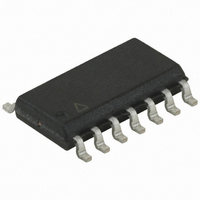ATTINY24A-SSU Atmel, ATTINY24A-SSU Datasheet - Page 35

ATTINY24A-SSU
Manufacturer Part Number
ATTINY24A-SSU
Description
MCU AVR 2K FLASH 20MHZ 14SOIC
Manufacturer
Atmel
Series
AVR® ATtinyr
Specifications of ATTINY24A-SSU
Core Processor
AVR
Core Size
8-Bit
Speed
20MHz
Connectivity
USI
Peripherals
Brown-out Detect/Reset, POR, PWM, Temp Sensor, WDT
Number Of I /o
12
Program Memory Size
2KB (1K x 16)
Program Memory Type
FLASH
Eeprom Size
128 x 8
Ram Size
128 x 8
Voltage - Supply (vcc/vdd)
1.8 V ~ 5.5 V
Data Converters
A/D 8x10b
Oscillator Type
Internal
Operating Temperature
-40°C ~ 85°C
Package / Case
14-SOIC (3.9mm Width), 14-SOL
Processor Series
ATTINY2x
Core
AVR8
Data Bus Width
8 bit
Data Ram Size
128 B
Interface Type
SPI, USI
Maximum Clock Frequency
20 MHz
Number Of Programmable I/os
12
Number Of Timers
2
Maximum Operating Temperature
+ 85 C
Mounting Style
SMD/SMT
3rd Party Development Tools
EWAVR, EWAVR-BL
Development Tools By Supplier
ATAVRDRAGON, ATSTK500, ATSTK600, ATAVRISP2, ATAVRONEKIT
Minimum Operating Temperature
- 40 C
On-chip Adc
10 bit, 20 Channel
For Use With
ATSTK505 - ADAPTER KIT FOR 14PIN AVR MCU
Lead Free Status / RoHS Status
Lead free / RoHS Compliant
Available stocks
Company
Part Number
Manufacturer
Quantity
Price
Company:
Part Number:
ATTINY24A-SSU
Manufacturer:
ATMEL
Quantity:
3 100
Company:
Part Number:
ATTINY24A-SSU
Manufacturer:
ATMEL
Quantity:
15 000
Part Number:
ATTINY24A-SSU
Manufacturer:
MICROCHIP/微芯
Quantity:
20 000
Part Number:
ATTINY24A-SSUR
Manufacturer:
ATMEL/爱特梅尔
Quantity:
20 000
7.3
7.4
7.4.1
7.4.2
7.4.3
7.4.4
8183C–AVR–03/11
Power Reduction Register
Minimizing Power Consumption
Analog to Digital Converter
Analog Comparator
Brown-out Detector
Internal Voltage Reference
The Power Reduction Register (PRR), see
vides a method to reduce power consumption by stopping the clock to individual peripherals.
When the clock for a peripheral is stopped then:
The peripheral should in most cases be disabled before stopping the clock. Clearing the PRR bit
wakes up the peripheral and puts it in the same state as before shutdown.
Peripheral shutdown can be used in Idle mode and Active mode to significantly reduce the over-
all power consumption. See
other sleep modes, the clock is already stopped.
There are several issues to consider when trying to minimize the power consumption in an AVR
controlled system. In general, sleep modes should be used as much as possible, and the sleep
mode should be selected so that as few as possible of the device’s functions are operating. All
functions not needed should be disabled. In particular, the following modules may need special
consideration when trying to achieve the lowest possible power consumption.
If enabled, the ADC will be enabled in all sleep modes. To save power, the ADC should be dis-
abled before entering any sleep mode. When the ADC is turned off and on again, the next
conversion will be an extended conversion. See
details on ADC operation.
When entering Idle mode, the Analog Comparator should be disabled if not used. When entering
ADC Noise Reduction mode, the Analog Comparator should be disabled. In the other sleep
modes, the Analog Comparator is automatically disabled. However, if the Analog Comparator is
set up to use the Internal Voltage Reference as input, the Analog Comparator should be dis-
abled in all sleep modes. Otherwise, the Internal Voltage Reference will be enabled,
independent of sleep mode. See
ure the Analog Comparator.
If the Brown-out Detector is not needed in the application, this module should be turned off. If the
Brown-out Detector is enabled by the BODLEVEL Fuses, it will be enabled in all sleep modes,
and hence, always consume power. In the deeper sleep modes, this will contribute significantly
to the total current consumption. See
able” on page 34
The Internal Voltage Reference will be enabled when needed by the Brown-out Detection, the
Analog Comparator or the ADC. If these modules are disabled as described in the sections
above, the internal voltage reference will be disabled and it will not be consuming power. When
• The current state of the peripheral is frozen.
• The associated registers can not be read or written.
• Resources used by the peripheral will remain occupied.
for details on how to configure the Brown-out Detector.
“Supply Current of I/O Modules” on page 182
“Analog Comparator” on page 128
“Brown-out Detection” on page 40
“PRR – Power Reduction Register” on page
“Analog to Digital Converter” on page 132
ATtiny24A/44A/84A
for details on how to config-
and
“Software BOD Dis-
for examples. In all
37, pro-
for
35


















